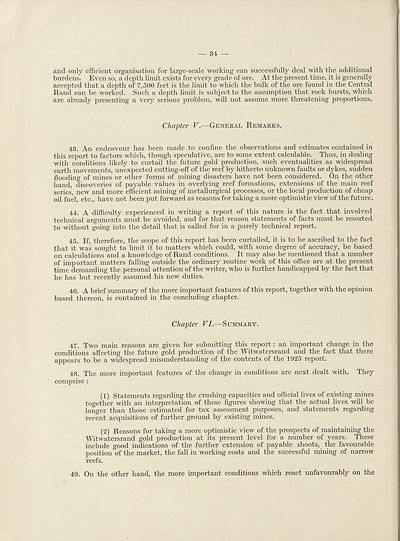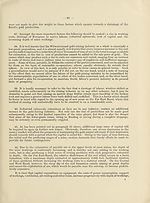Economic and financial section > Interim report of the Gold Delegation of the Financial Committee
(36)
Download files
Complete book:
Individual page:
Thumbnail gallery: Grid view | List view

— 34 —
and only efficient organisation for large-scale working can successfully deal with the additional
burdens. Even so, a depth limit exists for every grade of ore. At the present time, it is generally
accepted that a depth of 7,500 feet is the limit to which the bulk of the ore found in the Central
Rand can be worked. Such a depth limit is subject to the assumption that rock bursts, which
are already presenting a very serious problem, will not assume more threatening proportions.
Chapter V.—General Remarks.
43. An endeavour has been made to confine the observations and estimates contained in
this report to factors which, though speculative, are to some extent calculable. Thus, in dealing
with conditions likely to curtail the future gold production, such eventualities as widespread
earth movements, unexpected cutting-off of the reef by hitherto unknown faults or dykes, sudden
flooding of mines or other forms of mining disasters have not been considered. On the other
hand, discoveries of payable values in overlying reef formations, extensions of the main reef
series, new and more efficient mining of metallurgical processes, or the local production of cheap
oil fuel, etc., have not been put forward as reasons for taking a more optimistic view of the future.
44. A difficulty experienced in writing a report of this nature is the fact that involved
technical arguments must be avoided, and for that reason statements of facts must be resorted
to without going into the detail that is called for in a purely technical report.
45. If, therefore, the scope of this report has been curtailed, it is to be ascribed to the fact
that it was sought to limit it to matters which could, with some degree of accuracy, be based
on calculations and a knowledge of Rand conditions. It may also be mentioned that a number
of important matters falling outside the ordinary routine work of this office are at the present
time demanding the personal attention of the writer, who is further handicapped by the fact that
he has but recently assumed his new duties.
46. A brief summary of the more important features of this report, together with the opinion
based thereon, is contained in the concluding chapter.
Chapter VI.—Summary.
47. Two main reasons are given for submitting this report: an important change in the
conditions affecting the future gold production of the Witwatersrand and the fact that there
appears to be a widespread misunderstanding of the contents of the 1925 report.
48. The more important features of the change in conditions are next dealt with. They
comprise :
(1) Statements regarding the crushing capacities and official lives of existing mines
together with an interpretation of these figures showing that the actual lives will be
longer than those estimated for tax assessment purposes, and statements regarding
recent acquisitions of further ground by existing mines.
(2) Reasons for taking a more optimistic view of the prospects of maintaining the
Witwatersrand gold production at its present level for a number of years. These
include good indications of the further extension of payable shoots, the favourable
position of the market, the fall in working costs and the successful mining of narrow
reefs.
49. On the other hand, the more important conditions which react unfavourably on the
and only efficient organisation for large-scale working can successfully deal with the additional
burdens. Even so, a depth limit exists for every grade of ore. At the present time, it is generally
accepted that a depth of 7,500 feet is the limit to which the bulk of the ore found in the Central
Rand can be worked. Such a depth limit is subject to the assumption that rock bursts, which
are already presenting a very serious problem, will not assume more threatening proportions.
Chapter V.—General Remarks.
43. An endeavour has been made to confine the observations and estimates contained in
this report to factors which, though speculative, are to some extent calculable. Thus, in dealing
with conditions likely to curtail the future gold production, such eventualities as widespread
earth movements, unexpected cutting-off of the reef by hitherto unknown faults or dykes, sudden
flooding of mines or other forms of mining disasters have not been considered. On the other
hand, discoveries of payable values in overlying reef formations, extensions of the main reef
series, new and more efficient mining of metallurgical processes, or the local production of cheap
oil fuel, etc., have not been put forward as reasons for taking a more optimistic view of the future.
44. A difficulty experienced in writing a report of this nature is the fact that involved
technical arguments must be avoided, and for that reason statements of facts must be resorted
to without going into the detail that is called for in a purely technical report.
45. If, therefore, the scope of this report has been curtailed, it is to be ascribed to the fact
that it was sought to limit it to matters which could, with some degree of accuracy, be based
on calculations and a knowledge of Rand conditions. It may also be mentioned that a number
of important matters falling outside the ordinary routine work of this office are at the present
time demanding the personal attention of the writer, who is further handicapped by the fact that
he has but recently assumed his new duties.
46. A brief summary of the more important features of this report, together with the opinion
based thereon, is contained in the concluding chapter.
Chapter VI.—Summary.
47. Two main reasons are given for submitting this report: an important change in the
conditions affecting the future gold production of the Witwatersrand and the fact that there
appears to be a widespread misunderstanding of the contents of the 1925 report.
48. The more important features of the change in conditions are next dealt with. They
comprise :
(1) Statements regarding the crushing capacities and official lives of existing mines
together with an interpretation of these figures showing that the actual lives will be
longer than those estimated for tax assessment purposes, and statements regarding
recent acquisitions of further ground by existing mines.
(2) Reasons for taking a more optimistic view of the prospects of maintaining the
Witwatersrand gold production at its present level for a number of years. These
include good indications of the further extension of payable shoots, the favourable
position of the market, the fall in working costs and the successful mining of narrow
reefs.
49. On the other hand, the more important conditions which react unfavourably on the
Set display mode to:
![]() Universal Viewer |
Universal Viewer | ![]() Mirador |
Large image | Transcription
Mirador |
Large image | Transcription
Images and transcriptions on this page, including medium image downloads, may be used under the Creative Commons Attribution 4.0 International Licence unless otherwise stated. ![]()
| League of Nations > Economic and financial section > Interim report of the Gold Delegation of the Financial Committee > (36) |
|---|
| Permanent URL | https://digital.nls.uk/190953613 |
|---|
| Shelfmark | LN.II |
|---|
| Description | Over 1,200 documents from the non-political organs of the League of Nations that dealt with health, disarmament, economic and financial matters for the duration of the League (1919-1945). Also online are statistical bulletins, essential facts, and an overview of the League by the first Secretary General, Sir Eric Drummond. These items are part of the Official Publications collection at the National Library of Scotland. |
|---|---|
| Additional NLS resources: |
|

